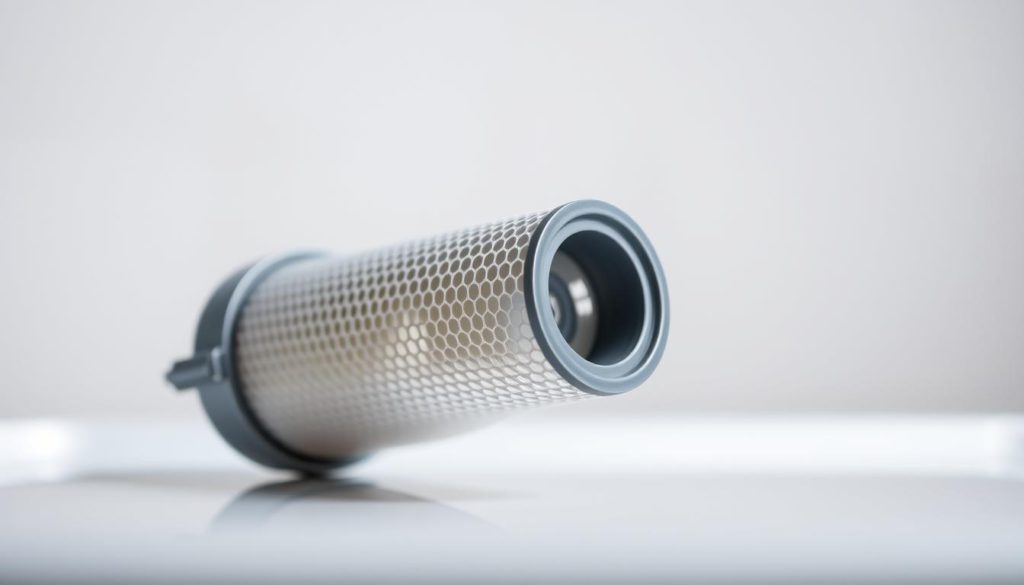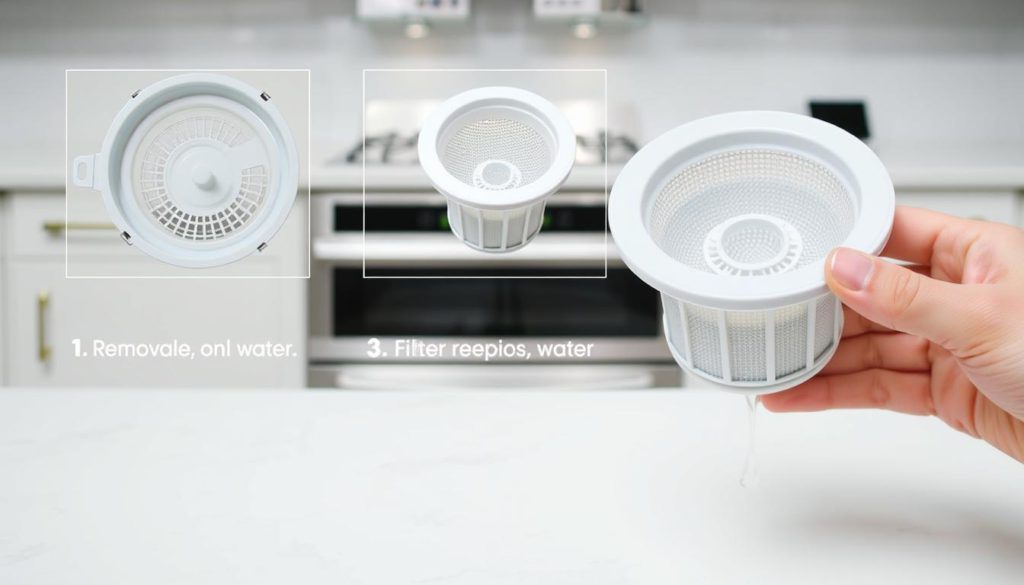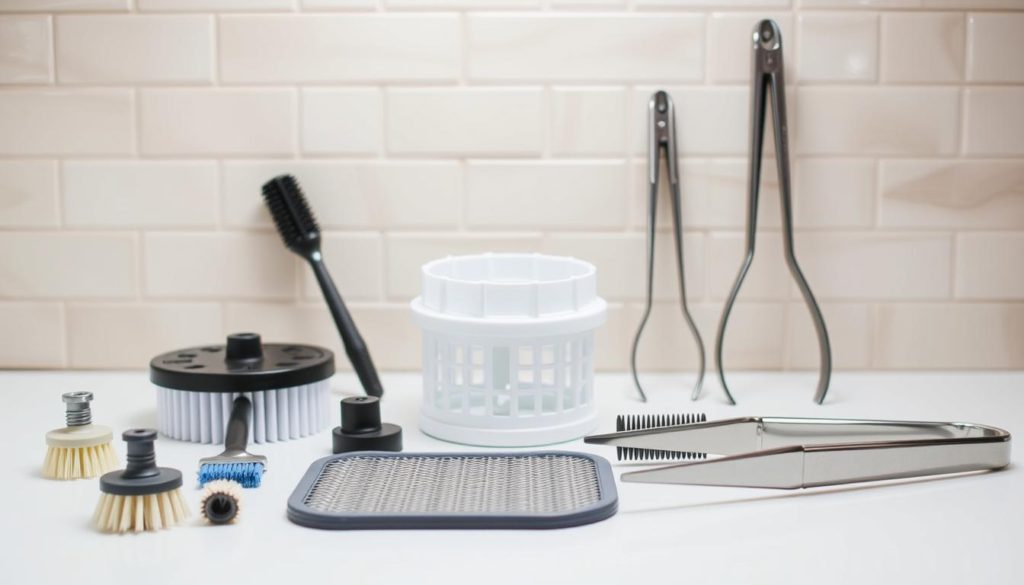You rely on your dishwasher to deliver spotless dishes, but what if the appliance itself is the problem? A hidden culprit—grime trapped in the filter—could sabotage your machine’s performance. Over time, food particles, grease, and debris accumulate, creating a breeding ground for odors and reducing cleaning efficiency.
Regular maintenance isn’t just about avoiding funky smells. A clogged dishwasher filter forces your machine to work harder, wasting energy and leaving residue on glassware or plates. Worse, neglecting this task could lead to costly repairs or shorten your appliance’s lifespan.
Locating the filter is simpler than you might think. Most models place it at the bottom dishwasher area beneath the lower rack. Whether your unit has a self-cleaning system or requires manual scrubbing depends on its design—checking the owner manual clarifies this quickly.
Key Takeaways
- A clean filter ensures hygienic dishes and optimal appliance performance.
- Debris buildup slows cycles and leaves streaks on glassware.
- Filters are typically located under the lower rack.
- Self-cleaning and manual-clean filters require different approaches.
- Regular maintenance prevents odors and extends your dishwasher’s life.
Ready to tackle this hidden chore? Below, you’ll learn how professionals remove stubborn buildup, avoid common mistakes, and keep your machine running smoothly for years.
Understanding Your Dishwasher Filter and Its Importance

Your dishwasher’s unsung hero lies beneath the lower rack. This component captures food scraps and grease before they wreak havoc. Without it, your machine would recycle debris onto plates and glasses during cycles.
How Dishwasher Filters Work
Modern units use two main designs. Self-cleaning models break down particles through powerful water jets, while manual systems trap debris in a mesh screen. Brands like Bosch® prioritize fine mesh layers, whereas Whirlpool® often includes twist-off filters for easy access.
Water flows through these barriers during each cycle. Larger particles get caught, preventing drain clogs. Smaller bits pass through but get flushed out with wastewater. This dual-action system keeps your dishwater clean and your pump protected.
The Role of the Filter in Protecting Your Appliance
A blocked filter forces the motor to strain, increasing energy use. Over time, this stress can damage internal components. Grease buildup also creates foul odors that transfer to dishes during drying phases.
Check your lower rack placement. Proper alignment ensures you can reach the filter for monthly maintenance. Clear instructions usually appear in your appliance manual—ignore them, and you risk shortened machine lifespan.
Step-by-Step Guide: How to Clean Your Dishwasher Filter Like a Pro

A few simple steps can restore your machine’s efficiency and prevent future issues. Start by emptying the appliance and removing the lower dish rack for clear access to the bottom area.
Locating and Removing the Filter
Most filters sit near the bottom spray arm. Twist the cylindrical component counterclockwise to release it. Some models have upper and lower assemblies—gently lift both sections. If unsure, your owner manual provides model-specific diagrams.
Cleaning Techniques and Best Practices
Rinse the filter under warm water to dislodge loose particles. For stubborn residue, mix mild soap with water and scrub using a soft brush (an old toothbrush works perfectly). Avoid steel wool or abrasive pads that could damage the mesh.
“Gentle scrubbing preserves filter integrity better than aggressive scraping.”
Reassemble components carefully, ensuring each piece locks into place. Run a quick rinse cycle to test for leaks. Consult your manual if the appliance makes unusual noises—a sign of improper installation.
- Frequency: Clean monthly or after heavy-use cycles
- Time required: 5-7 minutes
- Tools needed: Soft brush, dish soap, microfiber cloth
This routine prevents grease buildup and keeps particles from redepositing on dishes. Your appliance will thank you with quieter operation and spotless results.
Tips and Tools for Effective Dishwasher Filter Cleaning

The right tools transform filter maintenance from tedious to effortless. Start by gathering supplies that protect delicate components while removing stubborn grime.
Smart Tool Selection Saves Time
Opt for soft-bristle brushes or retired toothbrushes to scrub mesh filters. These prevent scratches that trap future debris. Avoid steel wool or scouring pads—they create micro-tears where grease accumulates.
- Nylon brushes: Gentle on fine mesh screens
- Microfiber cloths: Wipe down the spray arm housing
- Dish soap: Cuts grease without harsh chemicals
| Recommended Tools | Avoid | Alternatives |
|---|---|---|
| Soft nylon brush | Wire brushes | Old toothbrush |
| Liquid dish soap | Abrasive cleaners | Baking soda paste |
| Microfiber cloth | Steel wool | Sponge (non-scratch side) |
Target Trouble Zones Efficiently
Inspect the bottom rack track and spray arm holes monthly. Use a toothpick to clear clogged openings—this improves water flow. Soak heavily soiled filters in warm vinegar for 5 minutes before scrubbing.
Run a quick rinse cycle after reassembly. This flushes loose particles and tests your work. Spend 7-10 minutes weekly checking for food remnants near the drain place.
“Consistent 5-minute checks prevent 90% of dishwasher performance issues.”
These tips ensure your dishwashers operate at peak efficiency. Pair regular maintenance with gentle cleaning cycles to extend your appliance’s lifespan. You’ll notice cleaner dishes and quieter operation in no time.
Maintaining Your Dishwasher: When and How to Schedule Cleanings
Consistency keeps your appliance running smoothly. Create a schedule based on how often you run cycles—weekly checks for heavy users prevent surprises, while monthly cleanings suffice for lighter use.
Establishing a Regular Cleaning Routine
Start by tracking your weekly load count. Households running 5+ cycles weekly should inspect the bottom spray arm every 7 days. For 1-2 loads, a monthly check works. Always remove visible bits after rinsing dishes to reduce buildup.
- Heavy use (daily): Clean the filter every 2 weeks
- Moderate use (3x/week): Monthly maintenance
- Light use (1x/week): Check every 6 weeks
Run an empty hot water cycle with vinegar after deep-cleaning the clean filter. This removes hidden grease and sanitizes the tub.
Signs Your Filter Needs Immediate Attention
Gritty dishes or floating food particles signal trouble. Inspect the bottom spray arm for clogs—blocked holes reduce water pressure. Lingering odors or slow drainage also demand action.
“A single grain of rice in the filter can disrupt an entire cycle.”
Recheck the assembly after scrubbing. Ensure no bits remain trapped between mesh layers. Misaligned filters cause leaks, so verify the twist-lock clicks into place.
Mark your calendar for dishwasher cleaning days. Pair this task with other monthly chores to build the habit. Your machine will reward you with spotless results and fewer repair bills.
Conclusion
Keeping your dishwasher filter clean ensures sparkling results and protects your appliance. Regular maintenance stops bits of food from clogging the system while improving water spray efficiency. Follow your manual’s instructions to locate and remove the filter—most sit beneath the lower rack.
Use running water and a soft-bristled old toothbrush to scrub away grease. Mild soap dissolves residue without damaging mesh screens. Always check for trapped debris before locking the assembly back in place.
Set reminders to inspect your filters need attention monthly. Look for cloudy dish surfaces or unusual noises—these signal it’s time for a deep clean. Pair this routine with quick checks after loading bits of food-heavy loads.
Stick to the instructions provided here and in your owner’s guide. Proper care extends your machine’s lifespan and prevents 80% of common issues. With consistent effort, you’ll enjoy cleaner cycles and fewer surprises.
FAQ
Why does my dishwasher filter need regular cleaning?
Food particles, grease, and debris accumulate in the filter over time, which can block water flow and reduce cleaning efficiency. A dirty filter may leave residue on dishes or cause odors.
Where is the dishwasher filter located?
Most filters sit at the bottom of the appliance, beneath the spray arm. Check your owner’s manual for exact placement, as designs vary by brand (e.g., Bosch or KitchenAid).
Can I clean the filter without removing it?
No. For thorough cleaning, you’ll need to remove the filter. Soak it in warm, soapy water and scrub with a soft brush to dislodge stuck-on debris.
How often should I clean the filter?
Aim for monthly maintenance. If you run the appliance daily or notice leftover bits on dishes, clean it every 2–3 weeks. Always check for visible buildup first.
What tools work best for scrubbing the filter?
Use a soft-bristle toothbrush or a nylon brush to avoid damaging the mesh. For tough grime, soak the filter in vinegar before scrubbing.
Why is water pooling at the bottom of my dishwasher?
A clogged filter often causes poor drainage. Remove and rinse the filter, then inspect the spray arm for blockages. Run a rinse cycle to test the flow.
Can a dirty filter damage my appliance?
Yes. Blockages strain the pump and motor, potentially leading to costly repairs. Regular cleaning extends the appliance’s lifespan and improves performance.
Should I run a cleaning cycle after scrubbing the filter?
Yes. After reinstalling the filter, run an empty cycle with a dishwasher cleaner or vinegar to flush out residual debris and sanitize the interior.
